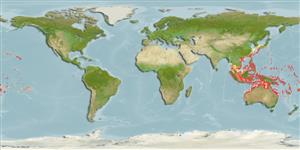>
Eupercaria/misc (Various families in series Eupercaria) >
Labridae (Wrasses) > Corinae
Etymology: Coris: Greek, kore, -es = pupil and also with themenaing of "maid" (Ref. 45335).
More on authors: Quoy & Gaimard.
Environment: milieu / climate zone / depth range / distribution range
Ecología
marino asociado a arrecife; rango de profundidad 0 - 50 m (Ref. 1602). Tropical; 37°N - 31°S, 96°E - 142°W
Pacific Ocean: Christmas and Cocos-Keeling Islands in the eastern Indian Ocean to the Society and Tuamoto islands, north to Japan and the Hawaiian Islands, south to Australia. Replaced by Coris cuvieri in the Indian Ocean (Ref. 37816).
Tamaño / Peso / Age
Maturity: Lm ? range ? - ? cm
Max length : 40.0 cm TL macho / no sexado; (Ref. 2334); common length : 20.0 cm TL macho / no sexado; (Ref. 27550)
Espinas dorsales (total): 9; Radios blandos dorsales (total): 12-13; Espinas anales 3; Radios blandos anales: 12. Juveniles easily recognized by their striking coloration. Females have a bright yellow caudal fin (Ref. 48636).
A solitary species (Ref. 90102) found in areas of mixed coral, sand and rubble of exposed outer reef flats, lagoon and seaward reefs (Ref. 1602, 48636). Benthopelagic (Ref. 58302). Feeds mainly on mollusks, crabs, and hermit crabs, and occasionally on tunicates and forams (Ref. 1602). Minimum depth reported taken from Ref. 128797.
Life cycle and mating behavior
Madurez | Reproducción | Puesta | Huevos | Fecundidad | Larva
Oviparous, with distinct pairing during breeding (Ref. 205).
Randall, J.E., 1999. Revision of the Indo-Pacific labrid fishes of the genus Coris, with descriptions of five new species. Indo-Pac. Fish. (29):74 p. (Ref. 33411)
IUCN Red List Status (Ref. 130435)
Threat to humans
Reports of ciguatera poisoning (Ref. 4690)
Human uses
Pesquerías: comercial; Acuario: Acuarios públicos
Más información
ReferenciasAcuiculturaPerfil de acuiculturaRazasGenéticaElectrophoresesheritabilidadEnfermedadesProcesamientoNutrientsMass conversion
Herramientas
Special reports
Download XML
Fuentes de Internet
Estimates based on models
Preferred temperature (Ref.
123201): 24.3 - 29, mean 27.9 °C (based on 690 cells).
Phylogenetic diversity index (Ref.
82804): PD
50 = 0.5000 [Uniqueness, from 0.5 = low to 2.0 = high].
Bayesian length-weight: a=0.00977 (0.00470 - 0.02030), b=3.07 (2.89 - 3.25), in cm total length, based on LWR estimates for this (Sub)family-body shape (Ref.
93245).
Nivel trófico (Ref.
69278): 3.5 ±0.2 se; based on diet studies.
Resiliencia (Ref.
120179): Medio, población duplicada en un tiempo mínimo de 1.4-4.4 años (Preliminary K or Fecundity.).
Fishing Vulnerability (Ref.
59153): Low to moderate vulnerability (30 of 100).
Nutrients (Ref.
124155): Calcium = 35.7 [14.0, 96.2] mg/100g; Iron = 0.552 [0.329, 0.970] mg/100g; Protein = 18.6 [15.7, 20.8] %; Omega3 = 0.128 [0.065, 0.250] g/100g; Selenium = 34 [13, 94] μg/100g; VitaminA = 98.9 [32.3, 339.5] μg/100g; Zinc = 1.85 [0.86, 3.31] mg/100g (wet weight);
